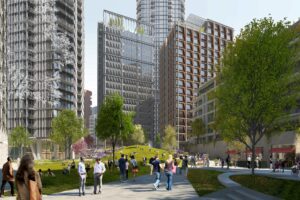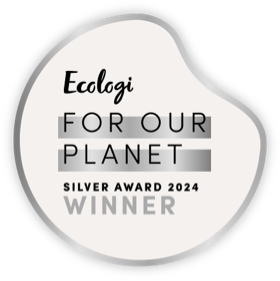Pedestrians prioritised in Acton regeneration
A major mixed-use development that will create a thriving new heart for North Acton has been given the green light. Plans for One Portal Way will deliver three high-rise triangular residential blocks. The towers, the tallest of which would be 56 storeys, are part of a seven-block phased development for Imperial College London. During a three-year partnership, Motion supported Imperial College London with design, masterplanning, transport planning and strategic advice on wider highway network improvements around North Acton.
The brownfield site will provide 1,325 new homes in close proximity to the future Old Oak Common Station. The scheme will also deliver 384 co-living or purpose-built student accommodation units and workspaces for up to 2,000 new jobs. Shops, cafés, a health centre and co-working hub will be centred around a park and accessed through three public squares.
Improved pedestrian links
Portal Way is currently an industrial and car-dominated service road. According to Alice Sewell, Investment Director, Imperial College London, “The new shared surface and crossing over the A4000 will transform the experience of pedestrians travelling between the site and North Acton station.” Alice adds, “We also experienced some challenges with the provision of servicing for the different plots around the gyratory. Motion was integral to the positive engagement with TfL.”
 Motion’s proposals included on-street delivery and servicing, and improved pedestrian links for the car-free development, with the majority of trips being reliant on bus, mainline rail and London Underground. Technical Director, Phil de Jongh, comments, “There was a desire to create a more open, safe environment for pedestrians and cyclists with wider footways, public realm improvements and a raised signalised crossing at the Portal Way and A4000 junction.”
Motion’s proposals included on-street delivery and servicing, and improved pedestrian links for the car-free development, with the majority of trips being reliant on bus, mainline rail and London Underground. Technical Director, Phil de Jongh, comments, “There was a desire to create a more open, safe environment for pedestrians and cyclists with wider footways, public realm improvements and a raised signalised crossing at the Portal Way and A4000 junction.”
Sustainability impact:
- Improving air quality – car-free development prioritising walking and cycling
- Solar panels, an electricity-only energy supply, air-source heat pumps and water-saving features to reduce carbon emissions and save energy
- Increasing biodiversity – landscaping and green spaces with a park at its heart
Image credits: © Pilbrow & Partners – photography by ©Justin Piperger. Photography/rendering produced by ©Wadsworth3d
An abridged version of this article first appeared in Issue 25 of Insight



